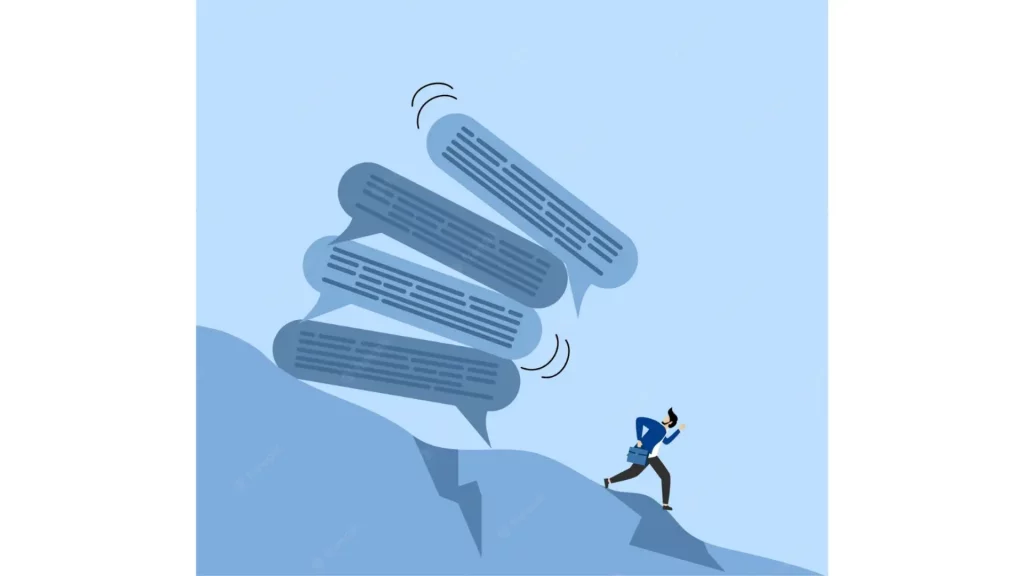The Role Of Overcommunication At Work With 3 Examples: Is It Good Or Bad?
Communication is the foundation of any successful workplace. It helps to build trust, create a positive company culture, and foster collaboration. Overcommunication, in particular, has become increasingly important in today’s remote work environment. But what exactly is overcommunication, and how does it differ from other forms of communication? In this blog post, we will explore the role of overcommunication in the workplace. We will discuss its benefits, such as avoiding confusion, providing purpose, building a positive company culture, and creating accountability. We will also cover when over-communication can go wrong and strategies for effective overcommunication. By the end of this post, you will better understand whether over-communication is good or bad for your workplace. Let’s dive in!What is Overcommunication, and what is its importance?
Overcommunication refers to excessive or redundant communication beyond what is necessary or productive. It can involve providing abundant information, repeating messages unnecessarily, or inundating others with constant updates or notifications. In today’s work culture, communication is vital, and overcommunication is crucial in ensuring everyone is on the same page. However, over communication goes beyond what is expected or necessary, and while it can be instrumental in remote work settings, it needs to be appropriately managed. Maintaining an open line of communication through constant updates can help build trust within the team and foster a positive work culture. Still, excessive communication can lead to information overload and decreased productivity. Therefore, striking a balance between effective communication and overcommunication is critical to achieving success in the workplace.How Overcommunication Differs from Under communication
Balancing communication in the workplace can be a challenge. Over-communication and under communication are two extremes that can both lead to negative consequences. Undercommunication can result in misunderstandings and mistakes, while over-communication can lead to information overload and confusion. Finding the right balance between too much and too little communication is crucial. When used effectively, over-communication can improve collaboration and productivity. However, it’s essential to refrain from excessive or unnecessary communication that could harm productivity rather than help it.How Overcommunication Differs from Information Overload
In today’s information age, it’s easy to confuse overcommunication with information overload. Although the two may seem similar, they are distinct phenomena that affect employees differently. Over-communication is the excessive communication of information, leading to confusion and misinterpretation. Information overload, on the other hand, refers to the feeling of being overwhelmed with too much information. While both can lead to decreased productivity and increased stress levels among employees, employers should focus on creating open communication channels and setting expectations for communication frequency to avoid overcommunication.Benefits of Effective Overcommunication
Effective over-communication can provide several benefits to the workplace, such as;- Enhanced clarity: Overcommunication ensures all relevant information is shared, leaving no room for ambiguity or misunderstandings. This can be particularly useful in complex projects or when dealing with critical instructions.
- Alignment and coordination: Over-communication can facilitate better coordination among team members or departments, helping to align efforts, prevent duplication of work, and ensure everyone is on the same page.
- Handling emergencies or crises: During emergencies or crises, overcommunication becomes crucial. Rapid and comprehensive dissemination of information can enable quick response, minimize risks, and ensure the safety and well-being of individuals involved.
- Customer satisfaction: In customer-facing roles, over-communication can be beneficial. Providing regular updates, offering proactive assistance, and being responsive to customer inquiries can enhance customer satisfaction and loyalty.
- Managing remote or distributed teams: Over-communication can be valuable when working with remote or distributed teams. Frequent check-ins, virtual meetings, and consistent updates can bridge the distance gap, foster collaboration, and maintain a sense of connection.
Other Interesting Reads
Strategies for Effective Overcommunication
Creating an effective overcommunication strategy is crucial to avoid misunderstandings and improve teamwork in the workplace. Here are some strategies;Keep it Simple
Effective communication is essential in the workplace, but it can be challenging to strike a balance between providing enough information and overloading team members with too much. That’s where keeping it simple comes in. When communicating with colleagues, it’s essential to use clear, concise language that everyone can understand. Avoiding technical jargon or expressions that may not be familiar to all team members can help ensure that messages are received and understood as intended. Additionally, repeating critical information help reinforce its importance and clarify any confusion. Check out “How To Practice Effective Communication In Leadership: A Guide For Leaders“Hold Short, Frequent Meetings
Holding short, frequent meetings can effectively prevent miscommunication and keep everyone on the same page. These meetings can discuss project status updates, address concerns, and clarify expectations. Regular check-ins allow team members to identify and resolve issues before they become larger problems quickly. It’s important to ensure that these meetings are focused and have a clear agenda to avoid wasting time. Technology like video conferencing can make it easier for remote team members to attend and participate in these meetings. Check out “What Time Management Skills Do For A Manager? A One-stop Guide“Mix-Up Modes of Communication
In today’s digital age, several modes of communication are available to us, from email and messaging apps to video conferencing tools. Mixing up the modes of communication can help ensure that important messages are received and understood. By using multiple channels, such as email, phone calls, and in-person meetings, you can prevent miscommunication and reach team members who prefer different forms of communication. Additionally, choosing the appropriate mode of communication depending on the urgency and complexity of the message can lead to effective over communication and better collaboration among team members.Be Open to Feedback
Building a culture of open communication is crucial to effective over communication in the workplace. Encouraging feedback and active listening can help prevent misunderstandings and improve team dynamics. When team members feel comfortable sharing their thoughts and ideas, they’re more likely to be invested in the project’s success and the company. In addition, regular check-ins and follow-ups ensure everyone is on the same page while creating a culture of openness and trust. In turn, this leads to better collaboration, improved productivity, and, ultimately, growth for the business.Don’t Wait on News; Share Information before it’s a Problem
In today’s fast-paced work environment, it’s easy to fall into the trap of waiting for news to come to us. However, effective over communication means taking a proactive approach and sharing information before it becomes a problem. Waiting on the news can lead to misunderstandings, missed deadlines, and wasted resources. By creating clear communication channels and expectations, teams can ensure everyone is on the same page and that important information is shared on time. Regularly scheduled meetings or check-ins can keep everyone up-to-date without overwhelming them with too much information.
Over communication examples
- Excessive Email Updates: A team leader bombards their team members with frequent and lengthy updates on minor developments or routine tasks, leading to email overload and decreased productivity. The constant flow of information can make it difficult for team members to identify and prioritize important messages.
- Micromanagement: A manager excessively checks in on employees, constantly requesting progress reports and task updates, even for routine or well-defined projects. This excessive monitoring can create a sense of mistrust, hinder autonomy, and impede employee productivity.
- Repetitive Meetings: A team holds multiple weekly meetings, often discussing the same topics or providing redundant updates. These meetings consume significant time and can leave employees feeling overwhelmed and frustrated, as they could have utilized that time for focused work.
Conclusion
Overcommunication can be a powerful asset for remote teams to stay connected and on track. It is a way to avoid confusion, keep everyone informed, and build a positive company culture. However, over communication can become overwhelming if not executed effectively. The key is to strike a balance and use strategies that work best for your team. For example, keep communication simple, hold short and frequent meetings, mix up modes of communication, be open to feedback, and don’t wait on the news. By implementing these strategies, you can create effective overcommunication in the workplace that will benefit your team’s productivity and overall success. Want more tips on to establish effective communication among your team and become a better manager, sign up for Risely- Manager’s Buddy!Strengthen your communication skills to build healthier workplaces.
Get your communication skills assessed now to understand hidden mistakes that hold you back.
FAQs
What is an example of overcommunication?
An example of overcommunication is constantly sending unnecessary and redundant messages or updates to team members, inundating them with excessive information that hinders their productivity and focus.
Is it possible to overcommunicate?
Yes, it is possible to overcommunicate. Overcommunication occurs when there is excessive communication, which can lead to information overload, decreased productivity, and frustration among team members.
When and why is over-communication important?
Overcommunication can be important during emergencies, crises, or when there is a need for transparency and alignment. It helps ensure clarity, coordination, and timely dissemination of crucial information.
Other Related Blogs
Executive Communication Coach: When And How To Choose
Executive Communication Coach: When And How To Choose Good communication is a must for professional success. After all, half of people management is all about saying the right things in…
Emotional Intelligence In Communication: 5 Ways Smart Leaders Act
Emotional Intelligence In Communication: 5 Elements Smart Leaders Use Effective communication is the cornerstone of a thriving workplace. It doesn’t matter if you’re speaking to your team members, clients, or…
15+ Sales Manager Best Practices to Boost Your Team’s Performance
15+ Sales Manager Best Practices to Boost Your Team’s Performance As a sales manager, you are responsible for achieving your targets and driving your team’s performance. It’s easy to get…
Communicating Employee Benefits is Essential: 5 Hacks to Do it Right
Communicating Employee Benefits is Essential: 5 Hacks to Do it Right Employee benefits are crucial in attracting, retaining, and engaging employees. However, it’s not enough to simply provide benefits; effectively…


